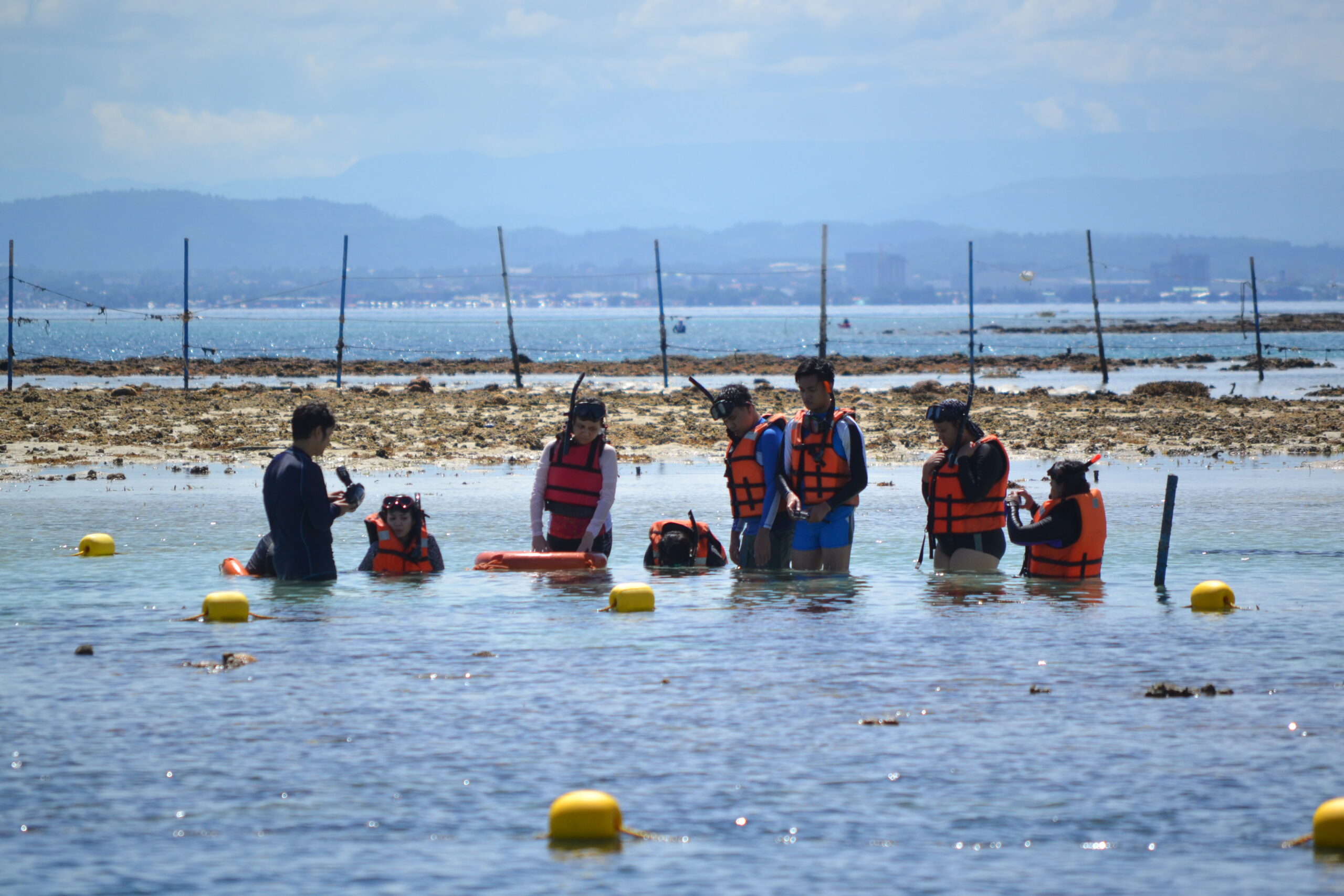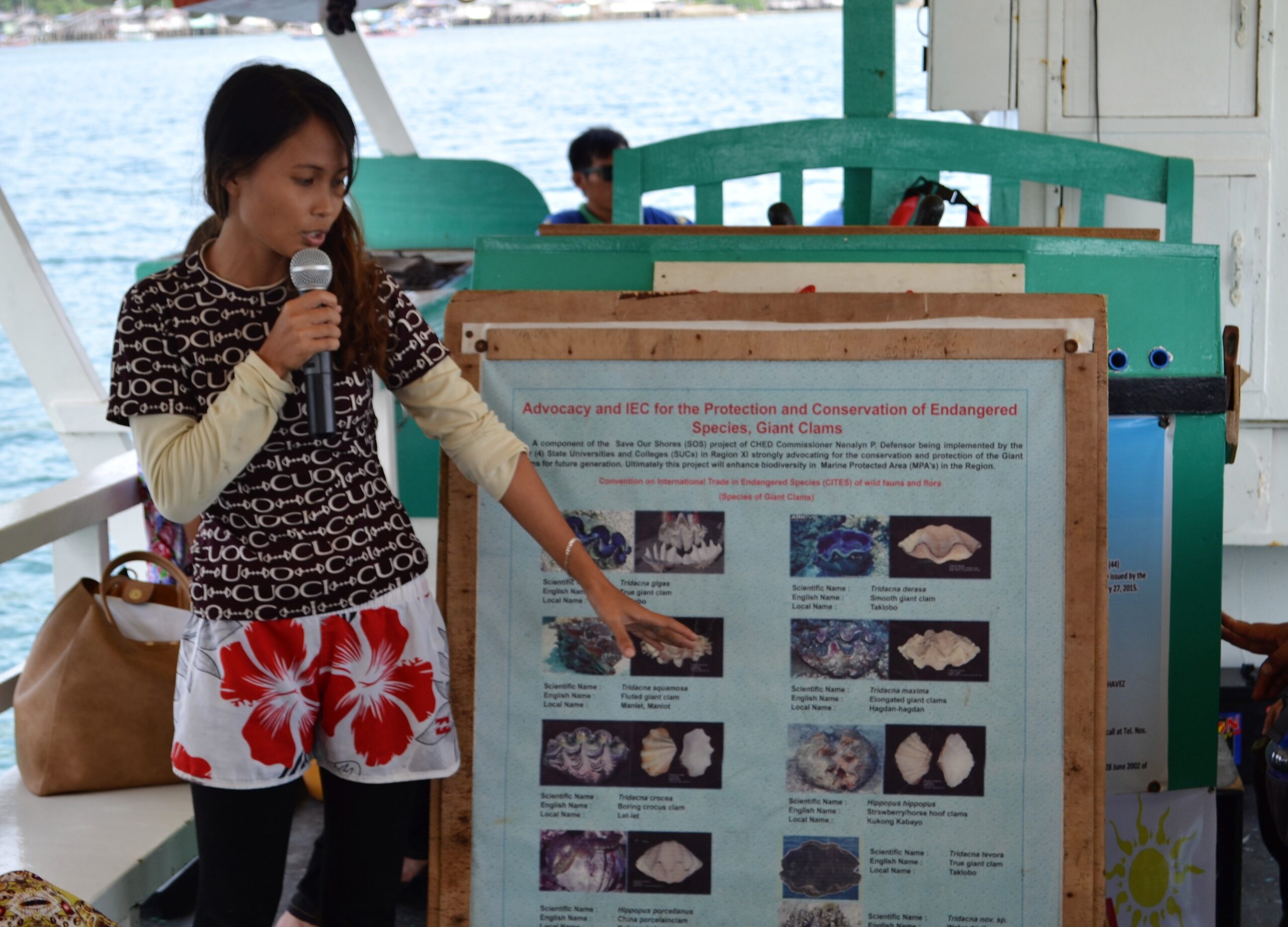By Henrylito D. Tacio
A Mati City-based marine conservation group raised concerns on the selling of giant clams and asked concerned agencies to provide fisherfolks sustainable livelihood programs to stop them from harvesting these endangered species.
“If these giant clams become extinct, the health of our coral reefs and marine wildlife species will be greatly affected,” said Amihan sa Dahican-Balod sa Paglaum, Inc. in a post shared in its Facebook account.
The group posted some photos of giant clams that were sold in a disclosed market. “These giant clams contribute significantly to our seas by counteracting eutrophication and giving topographic relief to coral reefs,” it pointed out.
According to the group, the giant clams were taken by some fisherfolk from Pujada Island, which has been named as one of the world’s most beautiful bays, a recognition given by the Most Beautiful Bays in the World Association.
The group said the illegal trade must be stopped. “We hope the government will give these local fisherfolks sustainable livelihood projects so that our waters will continue to be a tourist attraction, particularly now that we are promoting free diving and scuba diving.”
Giant clams are considered “endangered” species, per Fisheries Administrative Order (FAO) No. 208, series of 2001. They are listed under Appendix II of the Convention on the International Trade in Endangered Species of the Wild Flora and Fauna (CITES). Under this appendix, the species may not necessarily threaten, but their trade is controlled in order to avoid utilization incompatible with their survival.
In the Philippines, possession of any species under CITES Appendix II is a direct violation of Section 102 (b) of Republic Act No. 8550 as amended by Republic Act No. 10654. “It shall be unlawful to fish, take, catch, gather, sell, purchase, possess, transport, export, forward or ship out aquatic species listed in CITES Appendices II and III,” the law stated.
People who violate the law are liable either administratively or judicially, or both. Administrative liability has a corresponding penalty equivalent to three times the value of the species or P300,000 to three million pesos – “whichever is higher” – and forfeiture of the species.
A person who violates the law, if convicted by a court, results in a penalty of imprisonment of five to eight years and a fine equivalent to twice the administrative fine and forfeiture of the species.
Perhaps Mati City could learn something from the Adecor United Fisherfolk Organization. This group of fisherfolk based in barangay Adecor in Kaputian District of Island Garden City of Samal (IGACOS), with more than a dozen members, are the caretakers of the giant clams thriving in its waters.
The Marine Reserve Park and Multipurpose Hatchery, as it is called, is under the supervision of the local government unit of IGACOS. The giant clams were transplanted by the Giant Clam Stock Enhancement Program of the University of the Philippines-Marine Science Institute (UP-MSI). It is now a project of the Davao del Norte State College.
Aside from preventing the disappearance of giant clams in the country’s waters, the organization also helps in raising awareness of the importance of giant clams – which now number to more than 2,000 giant clams of different species – and providing livelihood to members.
The members do this through the Taklobo Tours, which includes an hour of snorkeling in the area. Visitors are brought by means of a motorized banca from the seashore to the floating cottage, where they are educated about the importance of giant clams.


After giving some instructions, the visitors are told to wear a life jacket and given a snorkel and a mask to those who are interested. Then, they swim to the area where the giant clams are being raised. As the water is clear, they can see the endangered species up close.
Started in 2013, Taklobo Tours is now one of Samal’s tourist activities. The success of the program proves that responsible tourism can flourish in a protected area for environmental conservation.
“Awesome and inspiring marine sanctuary that protects several species of giant clams,” commented one tourist who has visited the place. “With our snorkel masks on, we were led underwater by a certified guide to witness firsthand these amazing sea creatures. We also learned about their habitat, life cycle and feeding. A definite must-see.”
Officials from the Davao del Norte State College said the 14-hectare giant clam sanctuary helps empower and capacitate locals to become tourist guides and conservation warriors.
“We raise awareness by informing the people who come how endangered these giant clams are and that there are now laws regarding its preservation,” said Joel Gonzaga, one of the members of the organization. “It is now prohibited to harvest them and there are some consequences if they do so.”
According to Gonzaga, there are four species of giant clams introduced in Samal waters; these are Tridacna gigas (true giant clam), T. deresa (smooth giant clam), T. squamosa (fluted giant clam), and T. hippopus (strawberry clam or bear claw clam).
Of the 12 species of giant clams known to man, eight of them can be found in the coral reefs of the Philippines. Aside from the four species mentioned above, the other species are Tridacna crocea (boring clam), T. maxima (elongated giant clam), T. hippopus porcellanus (China clam), and T. noae ningaloo (Noah’s giant clam or teardrop clam).
The giant clams are raised along with the coral reefs. In fact, they are key to the country’s endangered coral reefs, according to Dr. Cecilia Conaco, of the Marine Science Institute (MSI) of the University of the Philippines Diliman.
Dr. Conaco, who is MSI’s deputy director of the Bolinao Marine Laboratory, said giant clams build and shape reefs aside from filtering water and recycling nutrients. They also serve as food factories.
More importantly, they provide shelter for different organisms. Serving as substrates of corals and sponges, marine biologists say giant clams – which can live in the wild reportedly up to over 100 years – help increase the residence of fishes and act as hiding places for other marine organisms.
“Like most corals, some anemones, and other reef organisms, giant clams utilize a combination of methods to obtain food,” explains Oceana, an international group focused solely on protecting the world’s oceans. “The majority of their energy is derived from symbiotic algae living within their cells, providing the clams with excess energy that they make via photosynthesis.”
In return, “the algae have a safe to live and receive the nutrients necessary to photosynthesize. The giant clams provide those nutrients by filtering feeding small prey from the water above the reef surface, which it siphons through its body. The beautiful, bright colors characteristic of individual giant clams is actually a result of the symbiotic algae.”
As giant clams cannot literally move due to their heavy weight (as much as 250 kilograms), they reproduce via external fertilization, where eggs and sperm are released into the water column at the same time. Although they are hermaphrodites, they cannot self-fertilize. “They are able to reproduce with other individuals that are close by,” Oceana explains.
Giant claims may not be endemic to the country, but the Philippines is one of the few countries where they can thrive. These bivalve mollusks reportedly live in the shallow coral reefs of the South China Sea, West Philippine Sea, Sulu Sea, Red Sea, but mainly in the Indian and South Pacific Oceans.
If the Philippines doesn’t watch out, giant clams may soon disappear from its waters. Generally, they are harvested for food. The meat of giant clams reportedly fetches P6,000 to P8,000 per kilogram.
In Japan, where it is known as “himejako,” the meat is considered a delicacy. Some Asian foods include the meat from the muscles of clams. In China, large amounts of money are offered for the adductor muscle, which the Chinese think to be an aphrodisiac.
These days, giant clams are valued for their shells. Touted as “jade of the sea,” the shells are seen as an alternative to ivory from elephant tusks. A Science feature reported these shells are sold from P150,000 to P600,000.
In China, where giant clam shells are a hit, they are made into carvings, jewelry, and other ornaments – “as status symbols for the wealthy and as protective charms in Chinese Buddhism.”
Dr. Conaco said the challenges to the conservation of giant clams in the country are overharvesting, habitat degradation, inefficient enforcement of national regulations, and unsustained support for conservation programs.
“We need to do something now before giant clams become extinct,” urges Dr. Rafael D. Guerrero III, an academician with the National Academy of Science and Technology (NAST).
Dr. Guerrero, however, believes there’s still hope for giant clams. “To save our giant clams, we should protect them in the wild from poachers (particularly foreigners) and promote their sea farming,” he suggested.

